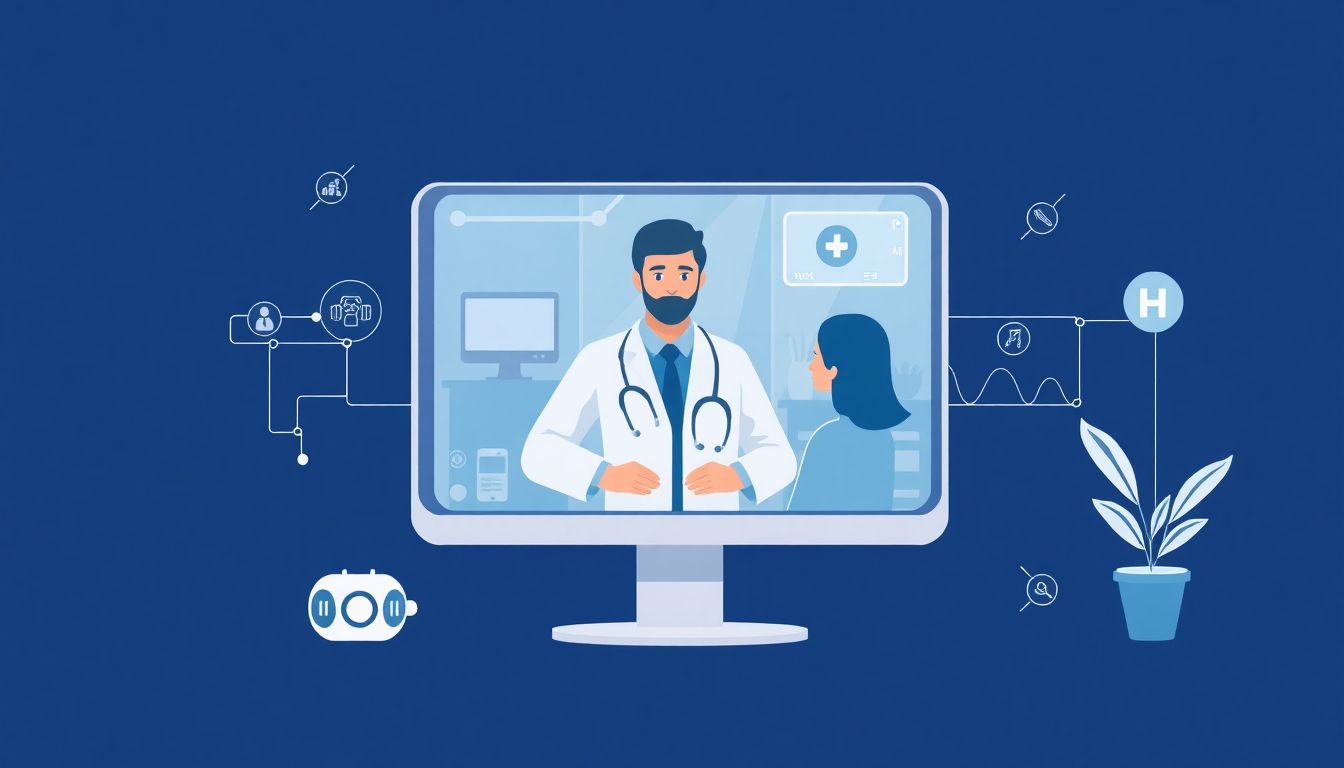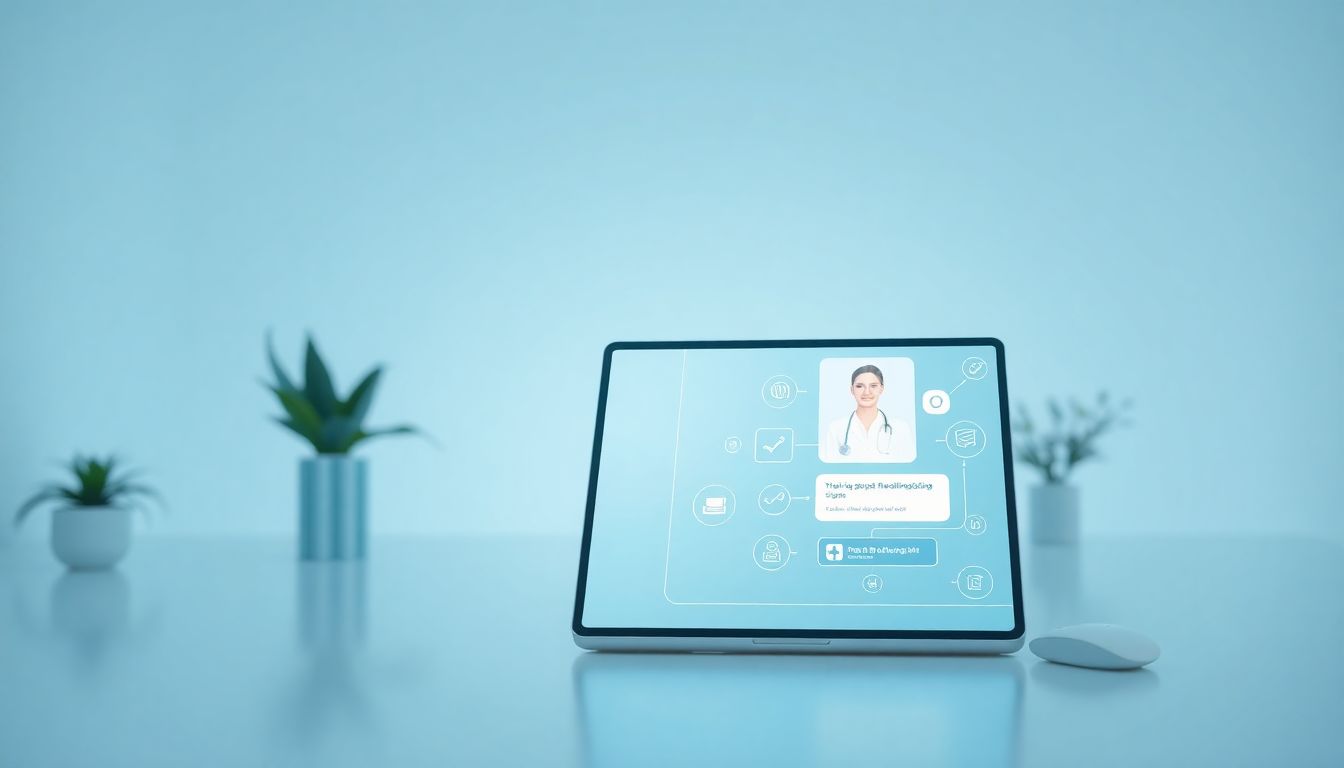Many people wonder how AI tools can make telemedicine smarter and easier to use. It’s true, AI is changing the game, helping doctors and patients connect better and faster. If you keep reading, you’ll see how these tools are making healthcare more accessible, especially by 2025. Plus, I’ll share simple steps for providers to jump into using AI in their own practices. Get ready to see what the future of doctor visits might look like!
Key Takeaways
– By 2025, AI telemedicine tools will enable faster, more accurate care through real-time data analysis, remote monitoring, and AI-powered triage apps. These improve diagnosis, reduce unnecessary visits, and help doctors catch issues early. AI-driven chatbots handle routine questions, freeing up clinicians for complex cases. AI’s role in imaging analysis ensures quicker, more reliable diagnoses, making healthcare more accessible and efficient for patients everywhere.
– Today, AI solutions like virtual triage, remote monitoring devices, and imaging software enhance telemedicine by prioritizing urgent cases, tracking patient health remotely, and assisting with diagnoses. Companies such as Zeiss and VITIMAGE are leading in integrating AI to boost accuracy, while chatbots support patient engagement, making virtual care smarter and more reliable.
– The core AI capabilities improving telehealth include natural language processing for human-like chat interactions, predictive analytics for early warning signs, and image recognition to help spot abnormalities fast. Combining these features with simple interfaces makes telemedicine easier, more effective, and more accessible for everyone.
– AI helps extend healthcare to remote and underserved areas by powering virtual assistants, enabling quick triage, and supporting continuous remote monitoring. This boosts health equity by offering initial guidance and ongoing care outside traditional clinics, especially in places with limited medical staff or long distances to hospitals.
– Challenges in AI telemedicine include data privacy concerns, algorithm bias, and infrastructure limits. AI systems can misdiagnose if not trained properly across diverse populations. Dependence on AI also requires clinicians to verify recommendations. Investing in strong cybersecurity, fairness audits, and reliable technology is key to overcoming these issues.
– Patients value the convenience of AI tools, like quick symptom checks and 24/7 chat support. Personalized care based on patient data improves trust, and shorter wait times increase satisfaction. Clear communication about AI’s role helps build confidence, while balancing AI with human contact ensures a caring patient experience.
– Providers should train staff on AI tools, understand their limitations, and improve digital infrastructure. Starting with small pilot programs, forming partnerships with tech firms, and establishing clear privacy policies help prepare for more AI adoption. Gathering feedback from patients and staff is essential to refine and effectively implement AI in healthcare practices.
– After 2025, AI will become even more advanced with better diagnoses, personalized treatment options, and better virtual assistant interaction. It could help predict health trends and outbreaks, and continuous monitoring via wearable tech will make preventive care common. Important updates in ethics and data policies will help ensure AI remains a helpful partner in healthcare.

1. How AI Telemedicine Tools Enable Better Patient Care in 2025
By 2025, AI telemedicine tools are making it easier for doctors to provide faster, more accurate care to patients. These tools can analyze patient data in real-time, helping clinicians spot issues early and avoid unnecessary visits. For example, AI-powered remote monitoring devices collect vital signs like heart rate and glucose levels, alerting both patients and doctors if there’s a problem.
Virtual triage apps powered by AI automatically sort patient symptoms by urgency, making sure urgent cases get immediate attention. This reduces waiting times and ensures resources are focused where they are needed most. Plus, AI-driven chatbots handle routine questions and symptom checks, freeing up clinicians for more complex cases.
AI also improves diagnoses by assisting with medical imaging analysis. Algorithms can interpret X-rays or MRIs with high accuracy, catching issues that might be missed by the human eye. As a result, patients get faster diagnoses, better treatment plans, and fewer hospital visits overall.
2. Key AI Solutions Used in Telemedicine Platforms Today
Today’s telemedicine platforms rely heavily on AI-powered solutions that make virtual healthcare smarter and more efficient. One major example is virtual triage systems that prioritize patient cases based on symptoms, ensuring those with urgent needs get quick attention.
Remote patient monitoring tools are another biggie. Devices that track vital signs continuously allow doctors to observe chronic disease patients from afar, intervening early when necessary to prevent hospital admissions.
Medical imaging analysis software, like those used for X-ray or MRI interpretation, helps radiologists and doctors spot abnormalities more reliably and faster. Companies such as Zeiss and VITIMAGE are increasingly integrating AI to improve diagnostic accuracy. Finally, AI chatbots serve as virtual assistants, handling common patient queries and symptom checks with high precision.
3. Core AI Capabilities That Improve Telehealth Services
AI’s ability to analyze vast amounts of data quickly is at the heart of its impact on telehealth. For starters, natural language processing (NLP) allows chatbots and virtual assistants to understand and respond to patient questions naturally, making interactions feel less robotic.
Predictive analytics enables AI to forecast patient deterioration or flare-ups in chronic conditions, prompting proactive care. This is especially helpful for managing conditions like diabetes or heart disease, where early intervention can save lives.
Image recognition and computer vision are also crucial. These capabilities help radiologists identify issues faster by automating the initial review of scans. As AI continues to evolve, combining these core skills with user-friendly interfaces makes telemedicine more accessible and reliable for everyone involved.

7. AI’s Role in Expanding Telemedicine Access Globally
AI is helping bring healthcare services to remote and underserved areas, especially where healthcare professionals are scarce.
By powering virtual assistants and chatbots, AI ensures patients in rural locations can get initial guidance without traveling long distances.
Automated triage tools can identify urgent cases quickly, prompting swift intervention even if there’s no nearby specialist.
AI-enabled remote monitoring devices make ongoing care possible outside traditional clinics, which is a game changer for patients with chronic conditions in isolated regions.
As AI technology becomes cheaper and more adaptable, it lowers the barriers to deploying telemedicine tools worldwide, supporting health equity efforts.
Healthcare providers should consider partnering with local tech firms or NGOs to implement AI solutions suited to specific community needs.
8. Challenges and Limitations of AI in Telemedicine
While AI brings many benefits, it’s not without hurdles—such as data privacy concerns, bias in algorithms, and reliability issues.
Patients and providers worry about how sensitive health data is stored and used, making data security a top priority.
Some AI systems may not perform well across diverse populations if they weren’t trained on representative data, leading to potential misdiagnoses.
Reliance on AI can cause overconfidence; clinicians still need to verify AI recommendations to avoid errors.
Technological infrastructure, like internet access and hardware, remains a barrier in many parts of the world.
To address these issues, healthcare systems should invest in robust cybersecurity and regularly audit AI models for fairness and accuracy.
9. Impact of AI on Patient Experience and Satisfaction
Patients often appreciate the convenience of AI-driven telemedicine, like quick symptom checks and 24/7 availability of chatbots.
Personalized recommendations based on patient data can make care feel more tailored, building trust in digital health tools.
Reducing wait times for diagnoses and treatment plans boosts satisfaction, especially in busy clinics or urgent care scenarios.
Some patients may still prefer human interaction, so blending AI with traditional care ensures everyone feels heard.
Clear communication about how AI is used and its limitations can help patients feel more comfortable and confident.
Hospitals and clinics should seek feedback from patients regularly to improve their AI-enabled services and address lingering concerns.
10. How Healthcare Providers Can Prepare for Increasing AI Adoption
To keep up, providers should train their staff to understand and work alongside AI tools effectively.
This includes learning about AI capabilities, limitations, and best practices for integrating these solutions into daily workflows.
Investing in reliable digital infrastructure is crucial, especially high-speed internet and secure data storage.
Building partnerships with tech companies can help tailor AI solutions specifically for their patient populations.
Creating clear policies around data privacy and AI governance will foster trust among patients and staff alike.
Start with small pilot projects to test AI solutions, then scale what works based on real-world results.
Engage with patients and providers in feedback sessions to refine AI tools and ensure they meet actual needs.
11. The Future of AI in Telemedicine After 2025
Looking ahead, AI is set to become even smarter, with capabilities like deep learning enabling more accurate diagnoses and personalized treatments.
We may see AI-powered virtual physicians providing initial consultations before humans step in for final decisions.
Advancements in natural language processing will make virtual assistants more human-like, improving communication and comfort.
AI will also help in predicting health trends and outbreaks, aiding public health efforts worldwide.
Integration with wearable tech will allow continuous, real-time health monitoring, making preventive care more routine.
However, ethical debates around AI decision-making and data ownership will need ongoing attention.
Investing in education and regulation now will help shape a future where AI enhances rather than replaces human touch in healthcare.
FAQs
AI tools enable faster diagnosis, personalized treatment plans, and remote monitoring, leading to better health outcomes and more timely care for patients in 2025.
Current AI solutions include chatbots for patient inquiries, image analysis for diagnostics, and predictive algorithms for patient risk assessment, all enhancing telemedicine services.
Capabilities like natural language processing, machine learning, and data analytics help in accurate diagnostics, personalized care, and efficient patient management in telehealth.
In 2025, trends include increased use of AI for remote diagnostics, predictive health analytics, and personalized treatment plans within telemedicine platforms.